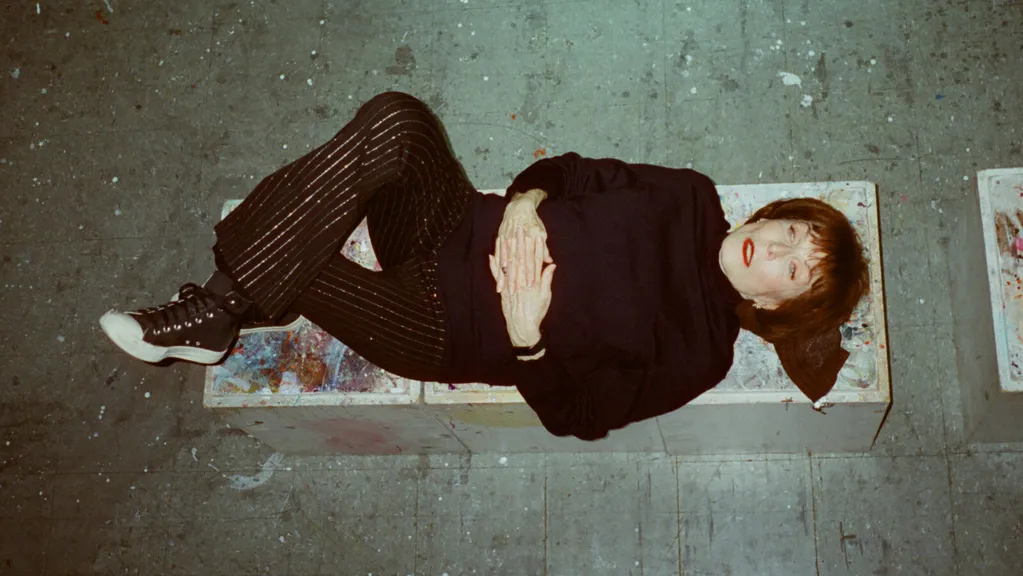At 77, Marilyn Minter is, as she recently put it, no longer in the "white hot" of her career. Her sensual, photorealistic paintings belong to important collectors and are found in museums like the Whitney Museum of American Art, but sell for less than male peers like Jeff Koons.
Ms. Minter is now the subject of "Pretty Dirty: The Life and Times of Marilyn Minter," a documentary by Jennifer Ash Rudick and Amanda M. Benchley that premiered earlier this year at the Hamptons Film Festival and is currently showing with DOC NYC.
"They thought I was underserved," said Ms. Minter with a shrug, standing in her studio in Midtown Manhattan, where she has worked for 14 years. "They were looking for somebody who wasn't in the vernacular and in the culture."
That might be because of whom -- and what -- Ms. Minter paints. She is drawn toward pop and political figures like Monica Lewinsky, Miley Cyrus and Pamela Anderson, often long before anyone else. "The people I shoot have been in the eye," she said. "They've been slightly broken or really broken by the system."
Her process is unique. Ms. Minter likes to photograph her subjects behind a clear glass or frozen glass panel, often clouded with steam. She then edits the photograph in Photoshop until she is happy with the composite image, and then paints it onto a metal panel.
She has captured an understanding of femininity, how women are expected to look and how they are aware of being perceived. Ms. Minter also has a sense of humor. She has a longstanding series of women's pubic hair, or what she calls her "bush paintings," depicted so closely that they become abstract forms.
The day of the interview, her studio was hung with paintings of MAGA hats, inspired, she said, by the midcentury painter Philip Guston.
Though Ms. Minter is the focal point, Ms. Benchley insisted that "this is not an art world movie. We hope you'll come for the art, but stay for Marilyn."
She and Ms. Rudick see Ms. Minter as a "survivor," believing she has made art exactly on her terms, and whose prescience and truth-telling have been underappreciated.
Ms. Minter was born in Shreveport, La., in 1948, but grew up in Miami Beach and Fort Lauderdale. Her parents split when she was young. She claims her father was "a gambler and an alcoholic" and left the home when she was 8. Her mother, a drug addict, was institutionalized a year after.
By the age of 13, Ms. Minter had already experimented with drugs and alcohol. "Those tables that are in front of your couch, I thought there were cocktail tables until I went to rehab. I never thought of them as coffee tables," she said. "I hated my life. I hated my family. And I thought, this is how I'm going to get by."
She could draw, however, and attended the University of Florida, where she took a course in photography and met Diane Arbus, a visiting artist. A series of photographs Ms. Minter took of her mother -- high in bed, smoking a cigarette in her nightgown -- impressed Ms. Arbus. By 1976, Ms. Minter had moved to New York City to pursue art.
The documentary covers many periods of her creative development, from when she collaborated in the early 1980s with the German expressionist Christof Kohlhofer to her infamous "Porn Grid" series in 1989 of graphic images lifted from pornography, which angered feminists, and left Ms. Minter an outcast. "I took for granted that women could embrace our own images for our own pleasure," she told Art Forum in 2015.
Ms. Rudick's husband, Joseph Rudick, is Ms. Minter's ophthalmologist. Ms. Minter was initially a reluctant subject. It took a year to convince Ms. Minter to participate. "I kept saying, 'I can't do this. I'm in the zone. You're keeping me from being in the zone," Ms. Minter said.
The film is culled from around 200 hours of footage mostly at home and in her studio, and includes scenes with figures like Jane Fonda, casually discussing having sex at their age (Ms. Fonda has been a subject of her work).
Her art often blurs the line between art and fashion imagery. She has, in fact, produced work for fashion brands like Tom Ford and for publications like The New York Times Magazine, where she created portraits of elderly people in intimate embraces.
After two years, she fully trusted the filmmakers, Ms. Rudick said. This was when Ms. Minter shared abusive letters she had saved from her mother, reading them out loud for the camera. Her mother tells her she's not an artist and that she should be ashamed of herself. "She was high," Ms. Minter said.
Ms. Minter recalled when one of her brothers called to say their mother had died: "I'd just gotten home around 7 a.m. from partying. I said 'Oh bummer. I got to go back to sleep. I'll call you later.'" She added of her mother: "She was just such a horror story. But now I've forgiven her because she was just a product of the culture. She was groomed to be a Southern belle and was engaged 17 times."
The artist has been sober for 40 years and is married to Bill Miller, a former stockbroker, who the documentary depicts as a loving, supportive partner. "He's not threatened by success," Ms. Minter said.
